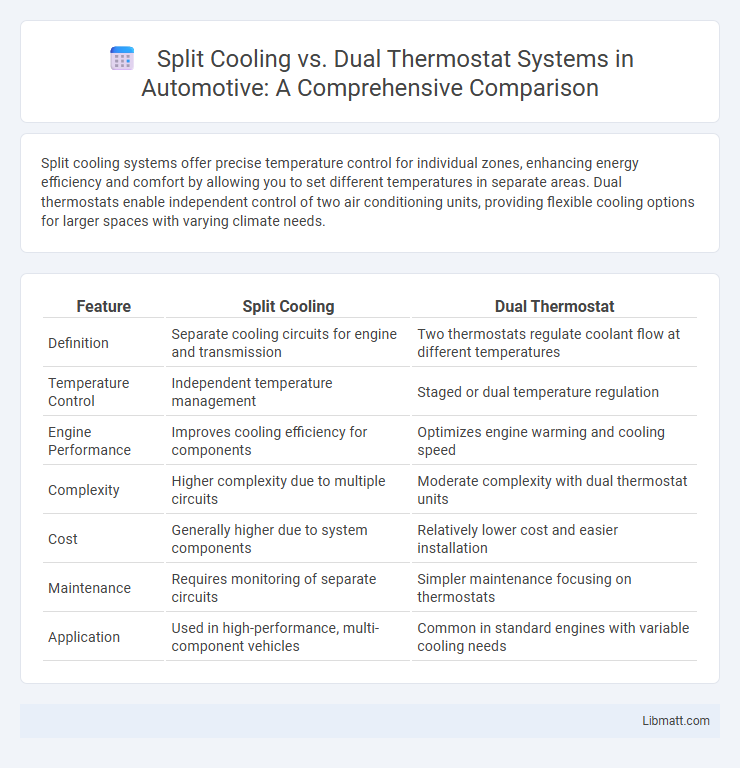Split cooling systems offer precise temperature control for individual zones, enhancing energy efficiency and comfort by allowing you to set different temperatures in separate areas. Dual thermostats enable independent control of two air conditioning units, providing flexible cooling options for larger spaces with varying climate needs.
Table of Comparison
| Feature | Split Cooling | Dual Thermostat |
|---|---|---|
| Definition | Separate cooling circuits for engine and transmission | Two thermostats regulate coolant flow at different temperatures |
| Temperature Control | Independent temperature management | Staged or dual temperature regulation |
| Engine Performance | Improves cooling efficiency for components | Optimizes engine warming and cooling speed |
| Complexity | Higher complexity due to multiple circuits | Moderate complexity with dual thermostat units |
| Cost | Generally higher due to system components | Relatively lower cost and easier installation |
| Maintenance | Requires monitoring of separate circuits | Simpler maintenance focusing on thermostats |
| Application | Used in high-performance, multi-component vehicles | Common in standard engines with variable cooling needs |
Understanding Split Cooling: An Overview
Split cooling systems consist of two main components--a compressor unit placed outside and an evaporator coil inside--working collaboratively to regulate indoor temperatures efficiently. By separating the cooling process into distinct zones, split cooling allows targeted temperature control and energy savings compared to traditional single-unit systems. This approach enhances comfort levels in individual rooms while reducing overall electricity consumption through precise thermostat management.
What is a Dual Thermostat System?
A dual thermostat system allows you to independently control the temperature in two separate zones within your home, providing personalized comfort and energy efficiency. Unlike split cooling systems that manage air conditioning in different areas through separate units, dual thermostats work with one HVAC system but enable distinct temperature settings for different rooms or zones. Your ability to adjust temperatures precisely helps reduce energy consumption and maintain optimal comfort throughout your living space.
Key Differences Between Split Cooling and Dual Thermostat
Split cooling systems regulate temperature through separate indoor and outdoor units, allowing precise cooling control in different zones, while dual thermostat setups use two thermostats to manage temperature independently in distinct areas. Split cooling offers energy efficiency by targeting specific zones, whereas dual thermostats provide flexibility in user preference without requiring multiple HVAC units. Your choice depends on whether you prioritize zoned cooling efficiency or customizable temperature control within the same system.
Energy Efficiency Comparison
Split cooling systems offer superior energy efficiency by independently controlling the temperature of multiple zones, reducing unnecessary cooling and minimizing power consumption. Dual thermostat setups allow two distinct temperature settings but lack the precise, zone-specific control of split systems, often leading to higher energy use. Studies show split cooling can reduce energy costs by up to 30% compared to dual thermostat systems due to optimized compressor operation and targeted cooling.
Installation Requirements and Costs
Split cooling systems require professional installation involving separate indoor and outdoor units with refrigerant piping and electrical connections, leading to higher upfront costs typically ranging from $3,000 to $7,000. Dual thermostat systems, often integrated into existing HVAC setups, have simpler installation demands as they control two zones using existing ductwork, resulting in lower installation expenses generally between $500 and $1,500. Both options impact overall energy efficiency, but installation complexity and cost are key factors in choosing between split cooling and dual thermostat solutions.
Comfort and Temperature Control
Split cooling systems provide precise temperature control in multiple zones, allowing users to adjust the cooling settings independently for each room, thereby enhancing overall comfort. Dual thermostats enable better temperature regulation by offering two separate control points within a single system, catering to different preferences in larger spaces. Both solutions improve energy efficiency by targeting cooling needs more accurately, reducing unnecessary energy consumption.
Maintenance and Longevity
Split cooling systems require regular maintenance such as filter cleaning and refrigerant checks to ensure optimal performance and extend unit lifespan. Dual thermostat setups allow for precise temperature control in different zones, reducing system strain and potentially increasing overall longevity. By choosing the right solution and performing consistent upkeep, you can enhance your cooling system's reliability and durability.
Ideal Use Cases for Split Cooling
Split cooling systems excel in environments requiring precise temperature control across multiple zones, such as large homes or office spaces with varying occupancy levels. These systems efficiently manage different cooling demands by independently regulating temperature in each area, improving energy savings and comfort. Ideal applications include multi-room residences, commercial buildings, and spaces with unique thermal loads or usage schedules.
Best Applications for Dual Thermostat Systems
Dual thermostat systems are best suited for homes or commercial spaces with multiple rooms that require individualized temperature control, enhancing comfort and energy efficiency. These systems allow you to set different temperatures for separate zones, making them ideal for areas with varying heating or cooling needs such as bedrooms, offices, or shared living spaces. Your energy savings increase as dual thermostats prevent unnecessary heating or cooling in unused zones, optimizing HVAC performance.
Choosing the Right System for Your Home
Selecting between split cooling and dual thermostat systems depends largely on your home's layout and cooling needs. Split cooling systems offer precise temperature control room by room, making them ideal for multi-zone comfort and energy efficiency. Your choice should consider the size of your living spaces, installation complexity, and the desired flexibility in managing individual room temperatures.
Split Cooling vs Dual Thermostat Infographic

 libmatt.com
libmatt.com